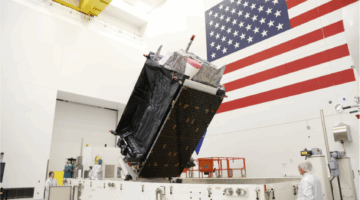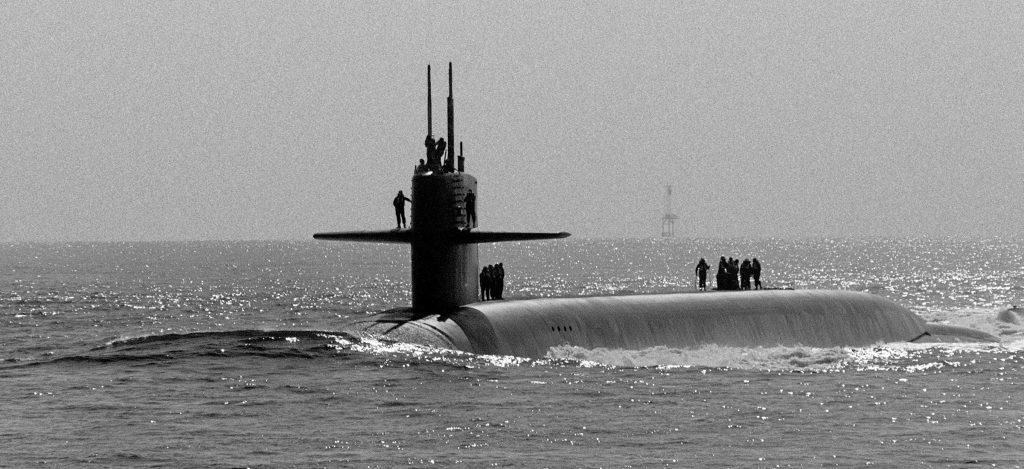
KING’S BAY, GEORGIA: Imagine drifting off to sleep underwater in a tiny room with eight other people, with nuclear missile tubes on either side.
Need a drink now? Too bad, because, while in theory the skipper can authorize alcohol, in practice he never will. You can eat canned asparagus every day though, if you want, thanks to a quirk in Navy nutrition regulations. (It’s unclear how much of it ends up compacted into cubes with the other garbage, weighted down, and dumped to the ocean floor). Oh, and as another health benefit, even though you live next to a mobile nuclear reactor, you get less radiation than the average American simply because you spend months at a time without seeing the sun.
Sounds less than homey? Well, apparently, you get used to it. That’s according to the crew of the ballistic missile submarine USS Tennessee (SSBN-734), homeported here in King’s Bay and currently tied up pierside for a refit.
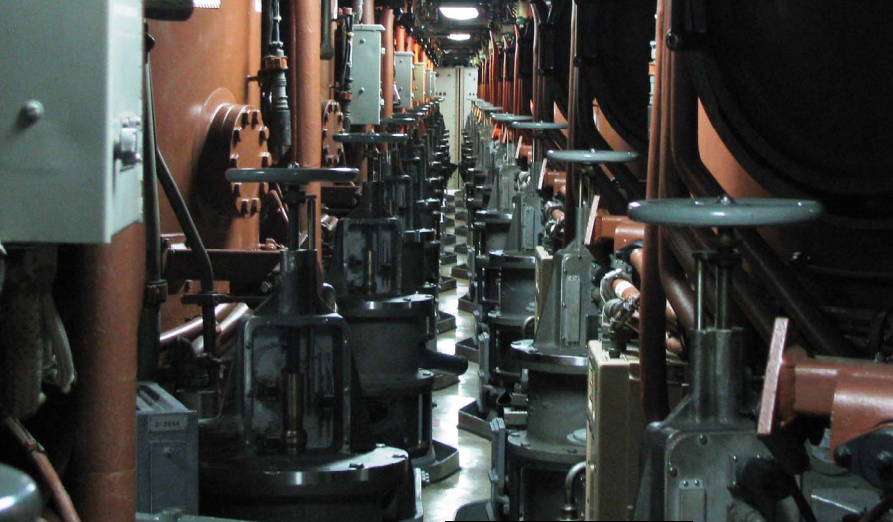
There’s an armed sailor in body armor standing guard on deck, plus trained dolphins and sea lions on watch for hostile divers. (Yes, really). When I and other attendees at a nuclear security conference here (courtesy of the DC-base Mitchell Institute and the local Camden Partnership) got the rare opportunity to tour a boomer, we had to leave our cellphones, cameras, and all other electronics behind before we boarded the Navy bus, which had been swept by security personnel and dogs. Even so, they never let us near the sub’s reactor — but the front end of the boat was intriguing enough.
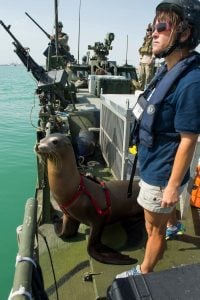
Inside the sub, the already cramped passageways were cluttered with temporary tubing. Every flat surface seemed covered by machinery being meticulously disassembled by several sailors, often standing with their backs nonchalantly to the two rows of 12 sequoia-thick silos that dominate the hull. The crew had even installed a temporary spiral staircase in their largest hatch to help them hustle in and out of the boat with supplies and spare parts. (Normally there’re no stairs aboard a sub, just ladders).
Just to turn up the heat a little, literally, the sub’s air conditioning had been turned off temporarily earlier in the day, while the boat moved berths. The reactivated A/C was still struggling to purge the July-in-Georgia heat from what is, after all, a big black metal tube with only a few hatches for ventilation. The only cool air aboard was right around the oxygen generator. The generator looks rather like Hell’s own espresso machine, but it actually splits ordinary water into oxygen — it’s the only thing that keeps the crew from suffocating underway — and hydrogen (vented offboard with the carbon dioxide), which is an endothermic (heat-draining) reaction. But while I was wilting just walking around, the sailors I saw at work seemed undaunted.
Which is busier, I asked one sailor: Being out on patrol, or being in port for a refit? Refit is, he said, “by far.” There’s a lot of work to do in 35 days at home being heading out to sea for two or three months. Each sub actually has two crews of over 150 each, Blue and Gold, who alternate to ease the strain on sailors and families. Even so, a career submariner like the skipper of the Tennessee, Commander Paul Seitz, spends an estimated six years of his life underwater.
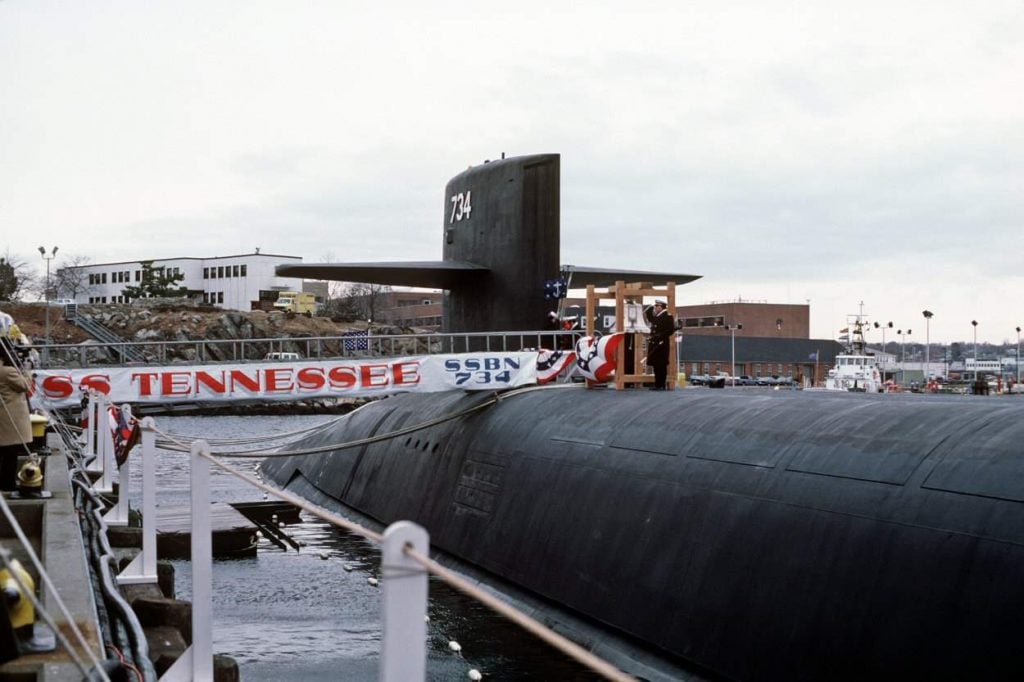
An Aging & Hard-Worked Force
So nuclear submarines are used hard every year, and this one is 32 years old. In fact, Tennessee was the first SSBN homeported at King’s Bay and the first boat to test-fire the Trident D5 missile. The other 13 Ohio-class nuclear missile subs stationed here and in Bangor, Washington were all commissioned between 1981 and 1997, and the US hasn’t built another SSBN since. (The newer Seawolf and Virginia submarines are relatively small attack boats that don’t carry nuclear missiles). The Navy’s now hustling to design and build the $128 billion replacement program, the Columbia class, with no slack left in the schedule.

Even so, Tennessee and her sisters will have to stay in service 42 years apiece before they can be replaced in the 2030s. The land-based Minuteman ICBM, the B-1 and B-2 bombers, and the Air-Launched Cruise Missile (ALCM) will also need replacements about the same time. The force also needs upgrades to aging nuclear warheads, Trident missiles, and the nuclear command, control, and communications network (NC3), as well as refurbishment of crumbling Energy Department buildings that in some cases date back to the Manhattan project. All that will put tremendous pressure on the Pentagon budget.
“Everything in that program delivers just on time to replace the old stuff,” said Gen. John Hyten, the four-star Air Force officer in charge of Strategic Command, to the nuclear weapons conference here.
“Every leg of the triad is up against the red line in terms of recapitalization,” agreed Rear Adm. John W. Tammen, director of undersea warfare (N97) on the Navy staff. “The green-eyeshade people…have repeatedly delayed and delayed each of the programs. (Now), the bottom line is there’s no additional margin for construction and delivery of Columbia.” To reduce the risk, defense contractors have already started building missile tubes — some of which will go to the Royal Navy‘s SSBN program — as well as a full-up prototype of the new design’s electric drive.

Is there any way, I asked, to squeeze some more years out of the Ohios, originally designed to last 30 years? “We have sharpened the pencils to get to 42 years,” he said. “I don’t think there’s anything past 42.”
So “we have to get Columbia done on time, (and) we are on plan to do that,” Tammen emphasized. “With the current leadership designating the strategic mission as DoD’s No. 1 mission, the resources are there.”
In the meantime, there’s some money to keep upgrading the existing equipment, but very selectively. So, like much of the US military, the sub is a strange mix of cutting-edge and vintage. There are plasma screens on the wall of the galley, the petty officer’s “Goat Locker,” and the captain’s office/stateroom/tiny cell, that display the condition of the sub in real time, all the time once underway.
But a lot of technology dates from the 1980s when the boat was built, including key components of the fire control system for the ballistic missiles. It turns out “clunky but tried and tested” beats “new hotness that’s mostly been debugged” when you’re working with nuclear weapons. And no, the crew told us, one man can’t launch the missiles: It takes at least two people turning keys at once in two different parts of the ship.
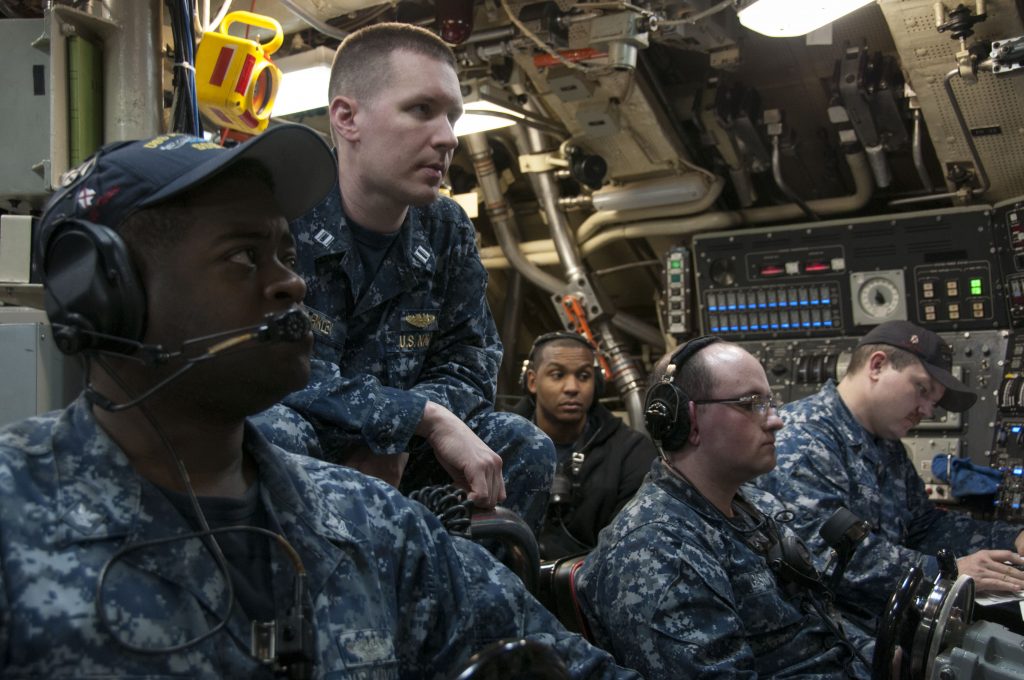
Saying “Thank You”
Does the crew suffer any existential dread from living, working, and sleeping next to enough megatonnage to kill millions of people? Apparently not. None of these submarines has ever fired a shot in anger as opposed to testing, and the sailors naturally prefer it that way. The whole point of a deterrent is, if it’s successful, you never have to use it. And while America’s land-based silos are visible to orbiting satellites, and its strategic bombers often make high-profile flights abroad to assure allies and unnerve adversaries, the submarines’ success lies in never being seen.
So it’s easy to overlook the service of US Navy submariners, or for the matter the Air Force missileers who go to work every day in bunkers deep underground, standing ready for the order we all pray will never come. And this weight is on some very young shoulders.
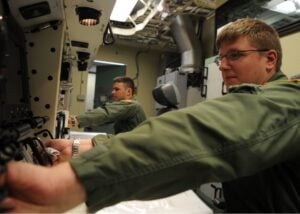
Gen. Hyten recalled how one junior lieutenant, working at Malmstrom missile base in Montana on her first assignment in the Air Force, asked how he responded when people derided the work ethic of millennials.
“What I say is, if you want to see our country, get on my plane and come with me,” Hyten said, voice breaking with emotion. “Come with me to Malmstrom, come to me to Kings Bay, and I’ll introduce you to the millennials that do the job every day — and you will find that they’re exactly the same as they were 20 years ago, exactly the same as they were 40 years ago.”
“They love this country. They want to defend this country. They go to work every day,” Hyten said. “They’re amazing — they’re smarter than we were, by far. They get motivated differently so you have to lead them differently, but their passion is just the same.”
It was at this point in his answer to the young lieutenant, Hyten said, that he saw a tear start down her cheek. “It’s pretty awesome that a missileer whose job is to sit on top of a nuclear weapon, a Minuteman III, takes her job that seriously,” he said. “Just saying thank you means a lot.”

